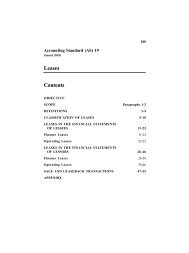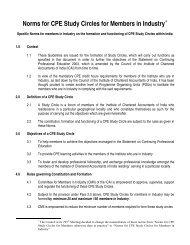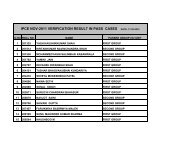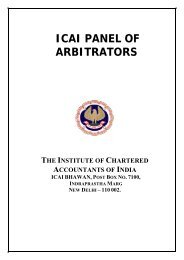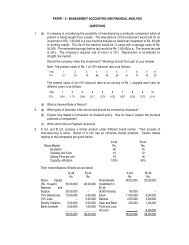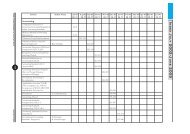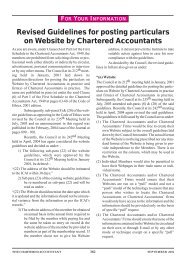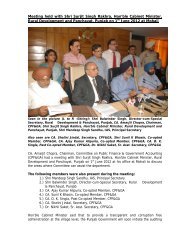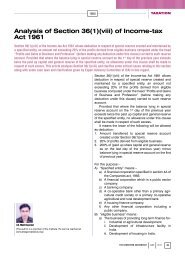The Chartered Accountant
The Chartered Accountant
The Chartered Accountant
Create successful ePaper yourself
Turn your PDF publications into a flip-book with our unique Google optimized e-Paper software.
DECEMBER 2008 980 THE CHARTERED ACCOUNTANT<br />
AUDITING<br />
New standards are an amalgam of international best practices and call for<br />
introduction of advanced risk management system with enterprise level<br />
applications. Hence it has become a daunting task to craft the required level<br />
of technological architecture, and assemble human skill across an institution<br />
undertaking such appraisal and across the industry which is dragging to<br />
overhaul itself. Also the managerial cadre has to be properly trained for<br />
understanding of critical issues for risk profiling of supervised entities and<br />
validating and guiding development of complex IRB models.<br />
Huge implementation cost may also impact profitability<br />
for smaller banks who are striving to meet the Basel<br />
II standards. <strong>The</strong> new framework is very complex and<br />
difficult to understand. It calls for revamping the entire<br />
management information system and allocation of<br />
substantial resources. <strong>The</strong>refore, it may be out of reach<br />
for many smaller banks. As Moody's Investors Services<br />
puts it, "It is unlikely that these banks will have the<br />
financial resources, intellectual capital, skills and large<br />
scale commitment that larger competitors have to build<br />
sophisticated systems to allocate regulatory capital<br />
optimally for both credit and operational risks.”<br />
To top it all, banks may have to keep additional capital,<br />
considering the possibility of under estimation of risks<br />
and the quality of risk management, as stated in the<br />
guidelines.<br />
Lack of Specific Guidelines<br />
When the Bank for International Settlements (BIS)<br />
proposed guidelines on the treatment of derivatives<br />
and other "trading book" issues, those guidelines ran<br />
smack up against provisions of the Bankruptcy Abuse<br />
Prevention and Consumer Protection Act of 2005 in<br />
US. Provisions of the new U.S. law, which takes effect<br />
October 17, 2008 enable companies to net out transactions<br />
between counterparties and across derivative<br />
product lines. <strong>The</strong> affected products include repurchase<br />
agreements, credit derivatives, energy derivatives, and<br />
interest-rate swaps. BIS provisions — part of the Basel<br />
II package of international capital guidelines — take a<br />
much more restrictive approach to cross-product netting<br />
than do the U.S. bankruptcy law or similar European<br />
legislation disallowing such cross netting. Hence the<br />
rule makers have themselves built in anomalies within<br />
the stipulated regulations resulting in conflicts in the<br />
regulatory regime of the country which was used as a<br />
framework for designing the global Basel accord and<br />
is now our issue of contention. This issue with BIS<br />
implementation in US has been mentioned here to describe<br />
that issues with BIS are not only with us but with<br />
the makers of the rules also. It's not up to these regula-<br />
tors to be telling us from Mount Everest what to do<br />
when they themselves are confused about the implementation<br />
of their own superseding guidelines.<br />
Above all, these norms provide only broad principles<br />
to help banks in developing their Internal Capital Adequacy<br />
Assessment Process. However, this situation will<br />
offer professional opportunities in the form of consulting<br />
contracts for the <strong>Chartered</strong> <strong>Accountant</strong> community.<br />
A Mixed Bag of risks<br />
<strong>The</strong> guidelines issued on Supervisory Review Process<br />
(SRP) 5 of Basel II accord ask banks to make provision<br />
for risks relating to credit concentration, liquidity, settlement<br />
risk, reputation, strategy, and under-estimation<br />
of credit risk that were not specified earlier. Providing<br />
an assortment of risks to banks not only makes this<br />
daunting task more demoralizing but gives room to<br />
all possible errors and assumptions on which the new<br />
banking accord is being predestined.<br />
toppling of interest Margins<br />
Under the Basel II credit rating is not mandatory but<br />
provides huge capital savings to the banks with rated<br />
portfolios. In case a bank chooses to keep some of its<br />
loans unrated, a provision of a flat risk weight of 150<br />
per cent for credit risk on such loans is imposed. After<br />
April 1, 2008 fresh unrated disbursals and renewals<br />
greater than Rs.500 million attract a risk weight of 150<br />
per cent. This minimum size will be further reduced<br />
to Rs.100 million bringing many more loans within the<br />
150 per cent risk weight bracket from April 1, 2009.<br />
Hence by getting loans rated, banks will be able to save<br />
capital on loans in the higher rating categories.<br />
A consequence of this mayhem is ruthless competition<br />
among banks for highly rated corporate needing<br />
lower amount of capital which is now exerting pressure<br />
on already thinning interest spread. If a bank has<br />
high quality credit exposures, it saves capital on account<br />
of credit risk. Conversely, a bank with relatively lower<br />
5 Supervisory Review Process refers to Pillar II of the Basel II accord. Pillar II requires Regulator to ensure that each bank has sound<br />
internal processes in place to assess the adequacy of its capital based on a thorough evaluation of its various risk as identified under the<br />
new accord.



